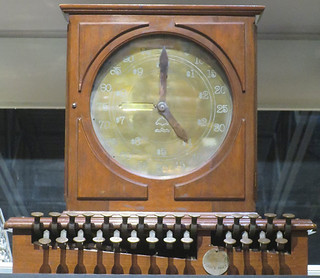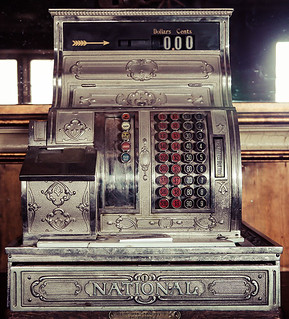
A CoinWeek article by Tyler Rossi delves into the history of the classic cash register, the temporary homes of most coins as they wend their way through circulation. Here's an excerpt - see the complete article online.
-Editor
If the store owner wasn't careful about who they hired, they could incur dramatic financial losses due to theft. One such businessman suffering from dishonest staff members was James J. Ritty, owner of the Pony House Restaurant in Dayton, Ohio. The story goes that inspiration struck Ritty when returning to America on an Atlantic steamship in 1878. If a machine could count the revolutions of a ship's propeller, then a similar mechanism could be used to count the money coming into his business. Shortly thereafter, Ritty partnered with his brother John to design and create what they called a cash register .
 While quite unusual looking, their first prototype included a large circular clocklike face above a single row of keys used to enter the sales price. Two sets of keys–one for cents (ascending in units of five) from five to 95 cents and dollars from $1 to $9–were located below the dial. The machine measured 22 x 14 x 20 inches or 55.88 cm x 35.56 cm x 50.8 cm.
While quite unusual looking, their first prototype included a large circular clocklike face above a single row of keys used to enter the sales price. Two sets of keys–one for cents (ascending in units of five) from five to 95 cents and dollars from $1 to $9–were located below the dial. The machine measured 22 x 14 x 20 inches or 55.88 cm x 35.56 cm x 50.8 cm.
However, Ritty's Dial, their first machine, did not actually include a cash tray. Instead, it was actually a sales recorder. Later, the brothers upgraded their device slightly, and in 1879 filed a patent for the new Incorruptible Cashier . After patenting the device, Ritty opened the new Cash Register and Indicator Company in Dayton in order to manufacture his new machines. It was then that a certain John H. Patterson, who owned three coal mines and a number of stores, purchased two of Ritty's first machines for $100 per machine (roughly $3,040 adjusted for inflation). According to Patterson, despite selling around $50,000 of merchandise annually (over $1.49 million adjusted for inflation), he was losing most if not all of it to thieving employees. After noticing that a clerk did not enter a sale into the store ledger around the same time, he received an advertisement from the Cash Register and Indicator Company. Notwithstanding his surprise at the machines' low quality, Patterson was surprised at how large an effect they had on his staff. In fact, he claimed to have recorded a $6,000 ($178,807 adjusted for inflation) profit only one year after acquiring the machines.
 However, being unable to manage the operations of both his salon and the new company, Ritty sold both the Cash Register and Indicator Company as well as the patent to his machine to Jacob H. Eckert of Cincinnati in 1881. This china and glassware salesman incorporated the company under a new name, National Manufacturing Company.
However, being unable to manage the operations of both his salon and the new company, Ritty sold both the Cash Register and Indicator Company as well as the patent to his machine to Jacob H. Eckert of Cincinnati in 1881. This china and glassware salesman incorporated the company under a new name, National Manufacturing Company.
Unlike the early wood types, many of the registers from this period were made from cast brass, and quickly became highly elaborate. Depending on what look the store owner wanted, they could order models made from cast-iron, wood, and metal, with finishes of polished brass, nickel plate, antiqued copper, paint, and silver and gold plate. At one point, due to the popularity of the brass models, the NRC Company operated one of the world's largest brass foundries.
The drawers in these new machines would have been used to hold a large variety of coins.
To read the complete article, see:
Ka-Ching! A Brief History of the American Cash Register
(https://coinweek.com/education/numismatic-history/ka-ching-a-brief-history-of-the-american-cash-register/)
Wayne Homren, Editor
The Numismatic Bibliomania Society is a non-profit organization
promoting numismatic literature. See our web site at coinbooks.org.
To submit items for publication in The E-Sylum, write to the Editor
at this address: whomren@gmail.com
To subscribe go to: https://my.binhost.com/lists/listinfo/esylum
Copyright © 1998 - 2024 The Numismatic Bibliomania Society (NBS)
All Rights Reserved.
NBS Home Page
Contact the NBS webmaster
|



